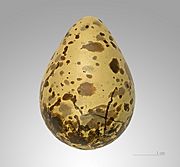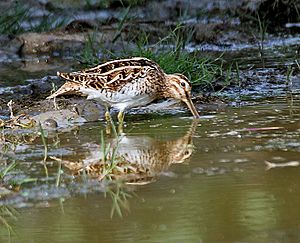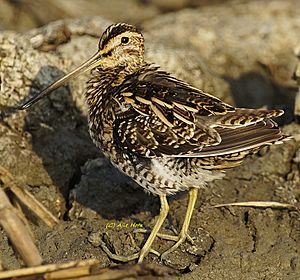Common snipe facts for kids
Quick facts for kids Common snipe |
|
|---|---|
 |
|
| Conservation status | |
| Scientific classification | |
| Subspecies | |
|
G. g. faroeensis |
|
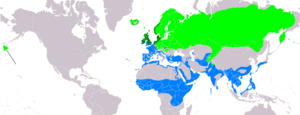 |
|
| Range of G. gallinago Breeding Resident Non-breeding | |
| Synonyms | |
|
The common snipe (Gallinago gallinago) is a small, plump wader bird. It is originally from the Old World, which means Europe, Asia, and Africa.
Contents
Where Do Common Snipes Live?
Common snipes breed in wet, marshy areas. These include marshes, bogs, and tundra across a large part of the world called the Palearctic. This area covers Europe and Asia.
In the north, they live as far as Iceland and northern Europe. They also live across European Russia and Siberia. In the east, their home stretches to places like Kamchatka and the Kuril Islands.
In Europe, you can find them in northern Portugal, central France, and northern Italy. They also live in Bulgaria and Ukraine. In Asia, they live south to northern Turkestan and through Manchuria.
Common snipes are migratory birds. This means they travel long distances. Birds from Europe fly south for winter. They go to southern and western Europe or Africa. Asian snipes travel to warmer parts of southern Asia.
What is the Common Snipe's Family Tree?
The common snipe was first officially described in 1758. This was done by a Swedish scientist named Carl Linnaeus. He gave it the scientific name Scolopax gallinago.
Today, the common snipe belongs to a group of 17 other snipe species. This group is called the genus Gallinago. The name gallinago comes from Latin words meaning "hen" and "resembling." So, it means "resembling a hen."
There are two main types, or subspecies, of common snipe:
- G. g. faeroeensis: This type breeds in Iceland and the Faroe Islands. It also breeds in the Orkney and Shetland Islands. In winter, it lives in the British Isles.
- G. g. gallinago: This is the most common type. It breeds in central and northern Europe and Asia. In winter, it moves to western Europe, Africa, Indonesia, and Japan.
The Wilson's snipe from North America used to be thought of as the same species. But now, scientists know it is a separate species.
What Does a Common Snipe Look Like?
Adult common snipes are about 25 to 27 centimeters (10 to 11 inches) long. Their wings can spread up to 44 to 47 centimeters (17 to 18 inches) wide. They usually weigh between 80 and 140 grams (2.8 to 4.9 ounces). Before they migrate, they can weigh up to 180 grams (6.3 ounces).
They have short, greenish-grey legs. Their bill is very long, about 5.5 to 7 centimeters (2.2 to 2.8 inches), and dark. Their body is mottled brown on top, which means it has spots and streaks. They also have straw-yellow stripes. Their underside is pale. They have a dark stripe across their eye, with lighter stripes above and below it. Their wings are pointed.
The common snipe looks a lot like other snipe species. The Wilson's snipe from North America is very similar. One way to tell them apart is by their tail feathers. Common snipes have seven pairs of tail feathers, while Wilson's snipes have eight. The Wilson's snipe also has a slightly thinner white edge on its wings.
How Do Common Snipes Behave?
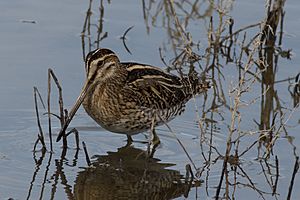
Common snipes are very good at hiding. Their brown, mottled feathers help them blend in with the ground. They are usually shy and stay hidden in plants. They only fly away if you get very close to them. When they fly, they make a sharp sound like "scape, scape." They fly in a zig-zag pattern to confuse any animals trying to catch them.
They find their food in soft mud. They use their long bills to probe the mud or pick up food they see. They mostly eat insects and earthworms. They also eat some plant material.
Courtship and Sounds
During mating season, male snipes perform a special display. They fly high in circles. Then, they make shallow dives. As they dive, their tail feathers vibrate. This creates a unique "drumming" sound. People have compared this sound to the bleating of a sheep or goat. Because of this, in many languages, the snipe is called names like "flying goat" or "sky goat." For example, in Finnish, it's called taivaanvuohi, which means "sky goat."
A scientist named Philip Manson-Bahr figured out how the snipe makes this sound. He discovered that two tail feathers are held at a 90-degree angle to the bird's flight path. When the bird dives, these feathers vibrate and make the sound. He even showed this to other scientists by attaching snipe feathers to a cork and spinning it on a string!
Breeding Habits
Common snipes build their nests on the ground. They choose a spot that is very well hidden. The female lays four eggs. The eggs are dark olive with brown spots. The female bird sits on the eggs for 18 to 21 days to keep them warm.
When the chicks hatch, they are covered in dark maroon downy feathers. These feathers have black, white, and buff markings. Both parents take care of the young birds. Each parent looks after about half of the chicks. The young birds are ready to fly in 10 to 20 days.
Is the Common Snipe Endangered?
Overall, the common snipe is not an endangered species. Its population is stable in most areas. However, in some parts of Europe, like England and Germany, their numbers are going down. This is mainly because their wet habitats are being drained for farming.
The common snipe is protected by an agreement called the Agreement on the Conservation of African-Eurasian Migratory Waterbirds. This agreement helps protect birds that migrate across Africa and Eurasia. In many places, the common snipe is still hunted as a gamebird.
Old Names for the Common Snipe
In the past, people had different names for the common snipe. Some old folk names include "mire snipe," "horse gowk," and "heather bleat."
See also
 In Spanish: Agachadiza común para niños
In Spanish: Agachadiza común para niños



